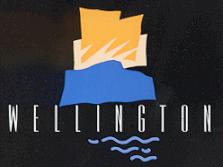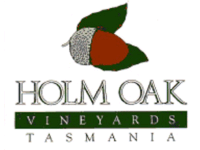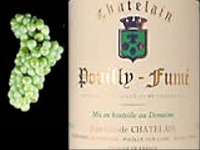
|
"taste... learn... ...enjoy!" |

|

|
| HOME | CONTACT US | TASTES | TIPS | TASTINGS |
|
TASTESHere's we have to say about some wines that we have tasted....
|
 Wellington
Pinot Noir 1999
Wellington
Pinot Noir 1999
Tasmania (Australia). HK$228 at Boutique Wines . [Mark says:] The sights, the sounds... the smells - of a true Pinot! Candy, caramel and that esential smell of GRAPE greet one's senses. I particularly enjoyed this '99 Tasmanian with a mouthful of milk-fed veal and mozzarella (courtesy of Cafe des Artistes in Central) as it amplified the sweetness and remained unwitherd by a sassy Provencale salsa. Hailing from Southern Tasmania - sone of the world's most southern and therefore cool-climate vineyards - the fruit is abundant in palate and classy in the finish. (Classy and sassy!) With its balanced mouthfeel and restrained tannins/oak, I would drink this luscious red anytime, and the pricetage makes it (almost) possible! Though drinkable now with a good decanting, Wellington's Pinot is a tad young. [Rick says:] Mark must have a really good decanter! I am quite partial to Pinot, mostly the influence of the Mrs. who loves the stuff, and this one clearly has all the markings of a good one. As Mark says, "Grape" (shocking!), some trademark plum and prune flavors and a nice full palate. However, I found the spiciness a little too much for a Pinot which made it just a bit "puckery". Definitely with a few more years in the bottle this wine will come into its own, unless you have a really good decanter (like Mark apparently), I'd tuck this away for a few. [2002 July]
|
 Hewitson
Old Garden Mourvedre 2000
Hewitson
Old Garden Mourvedre 2000
South Australia. HK$227 at Kedington Wines. [Rick says:] I know what you are thinking, Mourv-what-dre? I do believe this is the first 100% Mourvedre that I have tasted and believe me I am looking for more. This wine, whose grapes were grown in sandy-limestone soil in what is believed to be the oldest Mourvedre vineyard in the world, planted in 1853, starts with a tremendously peppery nose, with strong hints of arugula. The first tasting, reveals a full powerful wine (14% alcohol) with cherry undertones and a distinctive shirazy-ness (Barossa terroir perhaps?). As it sat in the glass over the course of the meal this wine opened up fabulously with even stronger cherry and fruit flavors and the spiciness mellowing considerable, it is definitely worth decanting and could probably last 15 years in the cellar, or 2 months in a Hong Kong summer. I enjoyed this wine with Oxtail Ravioli, but I would pair it with something a little fuller, possibly a braised rabbit and potatoes. [Mark says:] Dean Hewitson is a man of vision - vision made clear by his wines from South Australia. I thoroughly enjoyed this rare treat - a 100% Mourvedre wine. Full of flavor and aroma, taking on new forms as the minutes passed: musty tobacco, prune, arugula, candied fruit and nuts. Its tartness and full but balanced mouthfeel made it an excellent complement to my oxtail raviolo (courtesy of Daluca's in Central). Dean grew up with these ancient vines, and today purchases the pick of the crop from various Barrossa Valley vineyards - with a phenomenal result. Fabulous! [2002 July]
|
 Holm Oak
Riesling 2001
Holm Oak
Riesling 2001
Northern Tasmania, Australia. HK$148 at Boutique Wines . [Rick says:] By way of full disclosure (given the market conditions these days) I should probably make clear that it is one of the stated intentions of Good Tastings to wake Hong Kong up to the sublime joy of a good Riesling. Come on people, there is more than Bordeaux out there. With that said, we can move on to the Holm Oak. This wine is an exemplary model of a new world Riesling. Light and a bit tart, but not overwhelmingly so, followed by an explosion of grapefruit and green-apple citrusy goodness on the finish. It also displays a tiny bit of chalky mineral which balances out the citrus almost perfectly. I served this with prawn wontons with a mango salsa and it was a perfect match. Which brings me to "wonderful things about Riesling #6", it goes great with Asian food. [Mark says:] Rick is right: given the cuisine and the sweltering heat of Hong Kong - not to mention our relative proximity to Tasmania and New Zealand - one would expect Rieslings to be the most popular wines in the territory. Incredible that this Hom Oak shines through the onion-and-sweet of mango salsa - and amplified the fresh sweetness of a juicy pork loin. Versatile! I loved the striking fruit and mineral in both taste and smell - classic dry-style Riesling. I also loved the odd aromas: vegetal and linseed oil (think: freshly painted oil on canvas). Note, however, that this Riesling lacked balance; it just wasn't as pleasant to drink as a true top-notch Riesling. Hey, I hold Rieslings to high standards, and they often deliver! [2002 June]
|
 Felton Road
Dry Riesling 2001
Felton Road
Dry Riesling 2001
Central Otago, New Zealand. NZ$20.4 in N.Z. at Central Otago Wine Cellar. [Mark says:] A world-class Riesling! The aroma of lemon with lime and mineral gets your mouth watering for the tastes to come. And come they do - tightly balanced with a surprising tartness from first zingy taste to subtle finish. I'm sure there is some residual sugar woven into the balance. What's that nutty taste - perhaps the lingering honey of baklava? Incredible depth and subtlety, evolving as this young wine mates with open air. Restrained alcohol (10%) and clean tannin-free tartness make it a perfect match for fish, seafood, veggies, Cantonese, Vietnamese (the list is long, though the Felton Road "Riesling" in the semi-dry style is what you want for spicy or creamy dishes.) Enjoy it now but it will likely improve further for several years. [2002 June]
|
 Domaine Chatelain
Pouilly-Fumé “Les Charmes” 2000
Domaine Chatelain
Pouilly-Fumé “Les Charmes” 2000
Pouilly-Fumé, Loire, France. US$15. [Mark says:] Sings Sauvignon - screams it! - from the moment the abundant bouquet of fruit, seashells and dark leafy greens punches you in the nose. Lingering on the toungue, with spicey acid like lime zest, plus pears, citrus, herbs, minerals, gravel - this complex symphony sings in near-perfect harmony with great balance and mouthfeel despite the mightly 13% alcohol - perhaps the effect of taming 10% of this "savage" grape in oak. This is the taste that makes the rolling chalky hills of France's upper Loire Valley the world's heartland for Sauvignon Blanc. Will harmonize better and better for a few years. Was that a cat I heard? Domaine Chatelain, Les Berthiers, 58150 Pouilly-Sur-Loire, tel: 03 86 39 1746, fax 03 86 39 0113 [2002 May]
|
|||||||||||||||||||||||||||||||||||||||||||||||||||||||||||||||||||||||||||||||||||||||||||||||||||||||||||||||||||||||||||||||||
 Fournier
Sancerre Rouge 1999
Fournier
Sancerre Rouge 1999
Sancerre, Loire, France. HK$160 at Watson's. [Mark says:] You read correctly: this Sancerre is a red (rouge) made from pinot noir -- quite a surprise given that Sancerre is the holy land of sauvignon blanc. Like its famous white sibling, this red is smooth and drinkable -- fun to have in my mouth. No long finish, but no dry or nasty aftertastes either. Great with food: meats, fowl, sausage, fish, salad, fruit tart; taste the food and the wine at the same time. Taste: tart, cherry, strawberry; flowery finish. A bit thin, watery, but balanced: fruit, alcohol (12.5%), tartness, some tannin, spice. Nice -- like that price! [2003 Jan]
|
|||||||||||||||||||||||||||||||||||||||||||||||||||||||||||||||||||||||||||||||||||||||||||||||||||||||||||||||||||||||||||||||||
 Mount Maude
Riesling 2001
Mount Maude
Riesling 2001
Central Otago, New Zealand. NZ$14 in N.Z. at Central Otago Wine Cellar. [Mark says:] smell: chalk and lime, apricot, pineapple... fruit & mineral. feel: silky, balanced. taste: off dry, grape (white grape juice). finish: reasonably good, tart. Good w/ spicy Mexican (such as jalapeno salsa). 11.5% alc. [2002 Sept.]
|
|
We often are thanked by our many Tasting Guests for all of
the wonderful knowledge and trivia that we impart to them
in such a fun, friendly and effective way.
We also have many interesting questions emailed to us. We will answer them here - usually within a day or two. Are you planning a dinner party or picnic and wondering about wine? Just send us a note. Here are some recent questions with our Good Tastings answers....
Of course, there are some questions that we simply
don't have answers for.
We will keep a running list of these choice ponderances here.
|
GOOD TASTINGS - Saturday Night August 24
The Importance of the Grape
- 6 different varietals from around the world
GOOD TASTINGS - Saturday Night May 11
REVIEWSThere are many fine restaurants in Hong Kong. In our reviews, Good Tastings wants to help you to have a more enjoyable and affordable experience as you wine and dine. In this review, we critique the wine list at an excellent French restaurant - Le Tire Bouchon.
links to wine sources:
| |||||||||||||||||||||||||||||||||||||||||||||||||||||||||||||||||||||||||||||||||||||||||||||||||||||||||||||||||||||||||||||||||